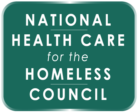Children, Youth & Families
According to the 2018 Annual Homeless Assessment Report to Congress, “just over 180,000 people in 56,000 families with children experienced homelessness, about 62,000 fewer people than in 2010, a 25 percent decline.” (p. 4) Still, children under the age of 18 comprise a fifth of all people experiencing homelessness (according to the Point-in-Time Count), and youth 18 to 24 make up 8.7% of the total population.
Progress on ending homelessness among children and youth has been made in large part to federal prioritization, but serving this subpopulation remains an important challenge. Follow the links below to learn more about how to tailor services to children and youth experiencing homelessness.
NHCHC Publications & Resources
Supplemental Anticipatory Guidance for Children and Adolescents Experiencing Homelessness | 2018 | Health Care for the Homeless Clinicians’ Network
A key component of well-child visits, anticipatory guidance—a proactive, age-based education and counseling technique—provides an opportunity for health care professionals, parents, and the child to ask questions and discuss issues of concern. This publication supplements standard anticipatory guidance to account for the unique challenges presented by homelessness that may affect a child’s health and development.
Engaging Youth Experiencing Homelessness: Core Practices and Services | 2016 | National Health Care for the Homeless Council
This publication describes in-depth practices and services that HCH agencies have found to be helpful in engaging youth experiencing homelessness. It incorporates trauma-informed, consumer-driven principles and addresses various challenges in youth engagement, providing a multitude of resources for information and guidance.
In Focus: Behavioral Health among Youth Experiencing Homelessness | 2015 | National Health Care for the Homeless Council
National Health Care for the Homeless Council | This issue of In Focus provides a synthesis of recent literature on behavioral health issues among homeless youth. It gives an overview of the homeless youth population, prevalence of behavioral health issues, factors that can impact these issues, and implications for practice and policy.
Engaging Homeless Youth: Recommendations and Resources | 2015 | National Health Care for the Homeless Council
This webinar identifies concepts of engagement, describes how services are part of engagement for youth, explores barriers to engagement, discusses the importance of youth involvement, and provides information on locating additional resources on providing services to youth.
Operation CHOICES: Nutrition and Fitness Programming to Combat Obesity and Food Insecurity for Families in Shelters | 2012 | National Health Care for the Homeless Council
This case report explores the issues of obesity and food insecurity experienced by families living in shelters, as well as demonstrating the impact of a shelter-based obesity prevention program.
Addressing Family Homelessness | 2012 | Healing Hands
This issue of Healing Hands identifies models and strategies to address and end family homelessness as it reaches levels that have not been reported since the Great Depression.
When the Bough Breaks. Families Experiencing Homelessness | 2010 | Healing Hands
This issue of Healing Hands explores the impact of homelessness and mental illness on parenting, and presents practice recommendations to support these families.
Additional Resources
Supportive Housing and Health Services for LGBTQIA+ Youth Experiencing Homelessness: Promising Practices | 2020
National LGBTQIA+ Health Education Center – This publication addresses health disparities that LGBTQIA+ youth experiencing homelessness face and focuses on ways to increase engagement of LGBTQIA+ youth into health and housing programs.
America’s Youngest Outcasts: State Report Card on Child Homelessness | 2014
National Center on Family Homelessness – This report presents the clearest snapshot yet of the 2.5 million children who are homeless each year—where they live and the consequences of their precarious situations. The report documents the extent of child homelessness, child well-being, risk for child homelessness, and policy and planning efforts for each state. Recommendations for state and federal action are also included.
Identifying and Serving LGBTQ Youth: Case Studies of Runaway and Homeless Youth Programs | 2014
To better understand provider experiences serving lesbian, gay, bisexual, transgender and Questioning (LGBTQ) runaway and homeless youth, this case study of four local agencies receiving grants from the Administration for Children and Family’s Runaway and Homeless Youth (RHY) Program reports on programs’ strategies for identifying and serving LGBTQ RHY, the challenges programs face in understanding and addressing the needs of this population, and potential areas for future research.
State Laws on Minor Consent to Routine Medical Care | Updated July 2019 | SchoolHouse Connection
This documents breaks down statutes by state related to minor consent to medical care, emancipation, and associated case laws.
Child Exposure to Trauma: Comparative Effectiveness of Interventions Addressing Maltreatment | 2013 | Comparative Effectiveness Review No. 89.
Prepared by the RTI-UNC Evidence-based Practice Center for the Agency for Healthcare Research and Quality, this report compares the efficacy of 24 clinical interventions for child maltreatment for children ages 0-14.
Emotional and Cognitive Impact of Chronic Homelessness on a Child | 2011 | Health Care for the Homeless, Inc. (Baltimore, MD), Children & Families Work Group, HCH Clinicians’ Network
This case report explores the impact of homelessness on child development, from communication skills to mental health.
Measures Review Database | National Child Traumatic Stress Network | SAMHSA funded
Free online searchable database that provides clinicians and researchers with in-depth information to enable them to choose the best instrument to assess children and adolescents who have experienced trauma. The Measures Review Database fills an important gap in the field. Its purpose is to promote the use of state-of-the-art measures for improved clinical intervention and research on child trauma.
Family Care Curriculum | Karen Hudson
This six-week program uses a train-the-trainer model, which combines attachment and trauma theory to train clinicians to help parents address their children’s developmental, emotional, and cultural needs while experiencing the stressors of homelessness.
Trauma-Informed Care: Perspectives and Resources | National Technical Assistance Center for Children’s Mental Health
This online tool consists of eight modules offering guidance on providing trauma-informed care to children, youth, and families through video interviews, issue briefs, and resource lists.
